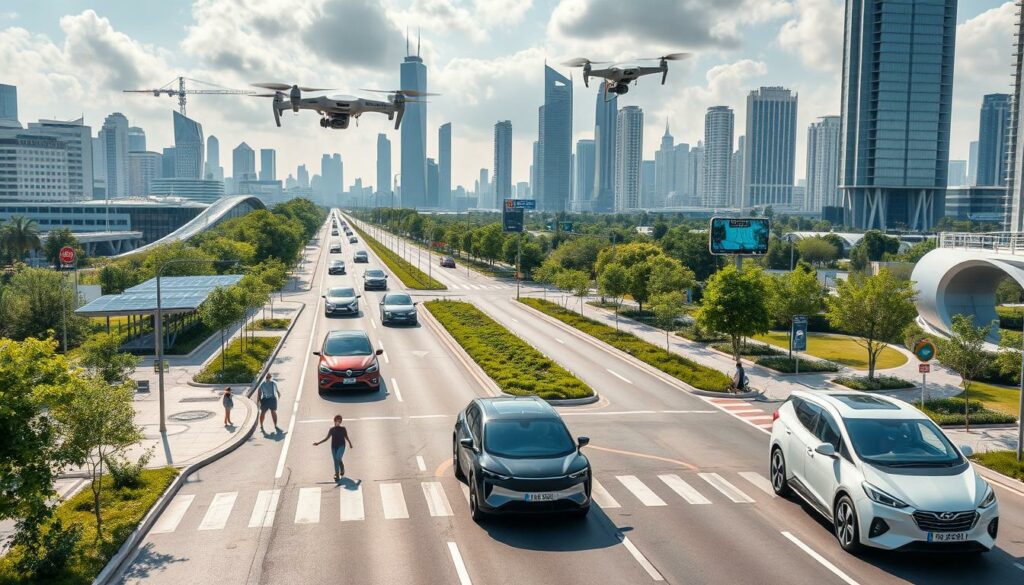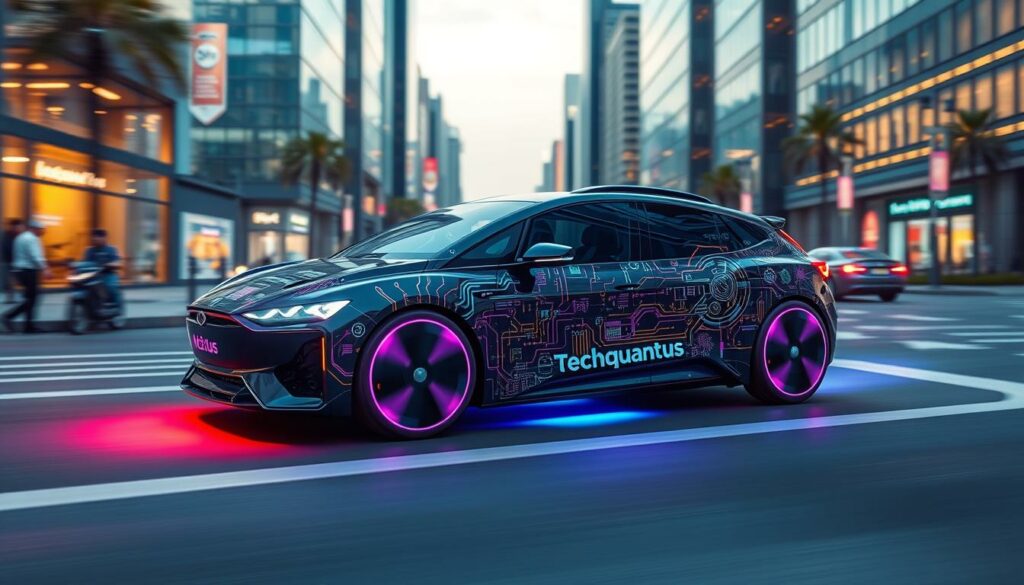In 2022, over 10% of fruits and vegetables worldwide went unpicked because of a lack of workers. This shows how much we need solutions like autonomous vehicles. These cars, powered by artificial intelligence (AI), are changing how we move around.
Self-driving cars are becoming more common, making transportation safer, more efficient, and accessible. They use a lot of data to move through tough places and make rides smooth for passengers. This change is big, not just in tech but in how we see getting around.
Companies like Tesla, Waymo, and Cruise are leading the way with their self-driving tech. As these cars start driving, AI controlling vehicles is no longer just a dream. It’s something we’ll see soon.
Key Takeaways
- AI-driven solutions are transforming mobility and transportation.
- Autonomous vehicles leverage real-time data to enhance passenger experiences.
- Companies like Tesla and Waymo are leading the charge in self-driving technology.
- The shift to autonomous driving promises improved safety and efficiency.
- As AVs become more prevalent, our understanding of mobility will fundamentally change.
- The integration of AI technologies is crucial in automating complex tasks within vehicles.
Understanding Autonomous Vehicles
Autonomous Vehicles use advanced self-driving tech to move and work on their own. This new way of driving makes roads safer and more efficient. The Society of Automotive Engineers (SAE) has levels for automation, from Level 0 (no automation) to Level 5 (full automation). Knowing these levels helps us understand how these vehicles work.
“As autonomous vehicles evolve, they are set to redefine transportation across industries.”
Key parts of autonomous tech include sensors, cameras, and LIDAR systems. These tools help vehicles see and understand their surroundings. They make decisions needed for driving. The tech behind vehicle automation also relies on complex algorithms that work fast.
Big names like AEye and NVIDIA play a big role in the market. They help make self-driving tech work in different vehicles. Now, car, tech, and insurance companies are working together. This leads to new ways to improve and spread out autonomous systems.
| Level of Automation | Description |
|---|---|
| Level 0 | No Automation |
| Level 1 | Driver Assistance |
| Level 2 | Partial Automation |
| Level 3 | Conditional Automation |
| Level 4 | High Automation |
| Level 5 | Full Automation |
The future of self-driving cars looks promising, with more money going into tech and infrastructure. Improving how we use big data and machine learning is key. As you learn more about self-driving tech, look into how it’s changing urban air mobility and other areas. For more info, check out this resource that talks about the industry.
The Rise of AI in Transportation
AI is changing how we move around cities. It makes vehicles smarter and helps with smart mobility by using data and learning machines. This leads to smoother traffic, less waiting, and safer roads, making trips faster.
Connected cars and smart traffic systems are key to this change. They collect data in real-time to make better decisions. Online maps help drivers find the best paths, and ride-sharing makes getting around cities easier. This shows how people want new services that make traveling better and quicker.
Experts say the AI in transportation market will grow a lot by 2031. Companies like Continental AG, Luminar Technologies, and Tesla are leading this change. They show how AI can improve everything from how cars work to how we use them.
As we face new challenges in transportation, knowing what drives the market is crucial. We need to look at growth plans, market size, and where it’s happening. North America and Europe are big players now, but Asia-Pacific is expected to grow fast. This shows how AI is set to change transportation worldwide.
Key Technologies Enabling Autonomous Vehicles
Autonomous vehicles use a mix of new technologies to work safely and well. Sensor technology, like LIDAR, radar, and cameras, is key. These sensors gather data on what’s around the vehicle. This helps the vehicle see obstacles and move over different landscapes.
Data fusion makes sensor technology even better. It combines data from various sensors. This way, vehicles get a clearer picture of their surroundings. It helps them make quick, safe, and smart choices.
Navigation systems are also crucial for self-driving cars. They use complex algorithms to understand sensor data and find the best path. GPS helps vehicles know exactly where they are. This means they can get to where they need to go safely and on time.
Connectivity tech like V2X lets vehicles talk to each other and the infrastructure around them. This makes driving safer and more coordinated on the roads.
- Sensor Technology: LIDAR, radar, and cameras for environmental analysis.
- Data Fusion: Integration of sensor data for improved accuracy.
- Navigation Systems: Algorithms and GPS for effective routing.
- Connectivity Technologies: V2X communications for enhanced safety.
Benefits of Autonomous Vehicles for Society
Autonomous vehicles bring many changes that can make society better. They make driving safer and more efficient. By cutting down on human mistakes, which cause many accidents, they could lower the number of crashes. This means everyone can feel safer when they’re on the road.
These vehicles also make it easier for people who have trouble moving around. The elderly and disabled will find it easier to get where they need to go. They won’t have to rely on others for rides, opening up more opportunities for them to be part of their communities.
Autonomous cars also change how we use services like ride-hailing and delivery. They make getting around cities easier and help manage traffic better. This could lead to cleaner air and less pollution, since cars are a big source of emissions in the U.S.

Autonomous vehicles can also help the economy. They will create new jobs in making these cars, keeping up infrastructure, and offering mobility services. As more people use electric cars, cities might see less pollution and higher property values near public transport. This could help cities grow and be more sustainable.
In short, autonomous cars offer more than just convenience. They can make us safer, give more people the chance to move around, and boost the economy. They also help with environmental issues. How well these benefits work out will depend on how we adjust to new ways of getting around.
| Benefit | Description |
|---|---|
| Transportation Safety | Reduction in human errors, leading to fewer traffic accidents. |
| Enhanced Mobility | Increased access to transportation for elderly and disabled individuals. |
| Economic Growth | Job creation in AV technology development and maintenance. |
| Environmental Impact | Reduction in greenhouse gases through optimized traffic and use of electric vehicles. |
Challenges Facing Autonomous Vehicle Adoption
The move to make autonomous vehicles a common sight faces many obstacles. One big challenge is getting people to accept them. Many are unsure about their safety, reliability, and how they’ll fit into our daily lives.
These doubts can slow down progress and make it hard to bring autonomous vehicles into our daily routines.
Technical hurdles also stand in the way. These vehicles need advanced software and hardware, which requires a lot of research and development. They also need updated roads and reliable networks to work well.
Creating algorithms that can handle different driving situations safely is another challenge. This makes things more complex.
Legal issues are also a big deal. Figuring out who is to blame in accidents with self-driving cars is a major concern. Making clear laws will help shape the future of these vehicles. Without good laws, overcoming technical and public acceptance challenges will be tough.
The Role of Artificial Intelligence in Autonomous Vehicles
Artificial Intelligence is key to making autonomous vehicles work. It helps these systems handle lots of data and make quick decisions. This is vital for safety and reliability as they move through unpredictable places.
Machine learning is a big part of this tech. It lets vehicles learn from different driving situations. The more they drive, the better they get at handling various conditions. This makes them more reliable.
Adaptive learning is also important. It lets vehicles learn from each trip, changing their ways based on what happens. This makes them safer over time.
At the heart of these vehicles are advanced algorithms. They help figure out the best way to get from point A to point B. They look at traffic, obstacles, and dangers. Predictive maintenance, powered by AI, also helps keep vehicles running smoothly. It can predict when parts might need fixing, avoiding breakdowns.

In short, AI, especially through machine learning and smart decision-making, makes autonomous vehicles safer and more efficient. This tech is changing how we travel, promising to make things better for everyone.
| Technology | Description | Purpose |
|---|---|---|
| AI in Autonomous Vehicles | Utilizes sensory data for real-time decision-making. | Ensures safety and reliability in navigation. |
| Machine Learning | Recognizes patterns in driving environments. | Improves vehicle response to diverse conditions. |
| Decision-Making Systems | Advanced algorithms guide navigation and route planning. | Optimizes travel routes and enhances safety. |
| Predictive Maintenance | Forecasts service needs to prevent mechanical failures. | Enhances reliability and reduces downtime. |
Case Studies: Success Stories in Autonomous Driving
The automotive world is changing fast, with many Autonomous Vehicle Case Studies showing success in different areas. Companies like Waymo and Tesla are leading the way in making cars drive themselves. They are setting new standards in safety and innovation.
Waymo, part of Alphabet Inc., is a leader in self-driving tech. They test their cars on real roads to make sure they’re safe. They’ve shown how their tech can make roads safer by reducing risks from human mistakes.
Tesla is always updating its software to make cars smarter. Their Autopilot feature makes driving easier and safer. They focus on making driving better for everyone, showing their vision for the future.
- Waymo’s extensive public testing shows how safe self-driving cars can be in real life.
- Tesla’s data-driven approach shows how self-driving tech works in everyday driving.
- Both companies work hard on following the rules and winning people over, making self-driving cars more accepted.
These stories teach us how to overcome challenges like public doubt and legal hurdles. By sharing their stories and data, these leaders help shape the future of self-driving cars. Their work inspires others and shows that focusing on safety and tech can bring big changes to driving.
The Future of AI in Transportation
The future of AI in transportation is a big change. It will bring new trends that change how we move around cities and manage traffic. AI will help make traffic flow better and reduce jams, which is a big step forward.
AI will also make routes smarter by using data. This will make traveling by car, bus, train, or ride-share faster and more efficient. Plus, electric vehicles with AI will be better for the planet, helping us meet global goals for sustainability.
Cities are using AI to make their transport systems better. They aim for safe, green networks that work well together. With self-driving cars, we’ll see more connected and strong transport systems.
| Timeline | Developments in AI Transportation | Market Value ($ Billion) |
|---|---|---|
| 2022 | Automotive Lane Keep Assist System Market valued | 7.2 |
| 2031 | Projected market value growth for Lane Keep Assist | 42.7 |
| 2023-2032 | Expected CAGR growth in Lane Keep Assist market | 19.9% |
AI is changing the car industry in big ways. It will make cars run smoother and safer. This means less time stuck in traffic and more reliable rides.
AI is opening up new chances for better logistics and supply chains. It will make traveling more personal and satisfying. These changes are leading to a new era of transport that’s efficient, green, and improves our lives.
Regulatory and Ethical Considerations
The rise of self-driving cars has made it clear we need strong rules for them. These cars are becoming more common, so we must make sure they’re safe to use. It’s important for government agencies and car makers to work together to set clear rules for how these cars should work and stay safe.
Self-driving cars face big ethical questions, especially when they can’t avoid accidents. These situations make us think about what’s right and wrong in how these cars make decisions. We need to rethink our values and how we see AI in this context.
Building trust in self-driving cars will require working together between the public and private sectors. This partnership can help create rules that make sure these cars are open and responsible. Laws must keep up with new tech to address concerns and help people understand how these cars work.
The future of self-driving cars depends on clear rules and ethical guidelines. These must focus on safety, reliability, and doing what’s right. By thinking carefully about these issues, we can make sure this new technology works well for everyone.
Market Trends and Predictions for Autonomous Vehicles
The Autonomous Vehicle Market Trends show a fast-changing scene. This is due to big changes in how people act, new tech, and big partnerships. Looking ahead, these trends suggest a strong growth for self-driving cars.
Recently, electric car sales have jumped, thanks to cheaper batteries. Big companies are putting more money into making parts like motors, batteries, and charging stations. This matches the trend of people wanting personalized in-car experiences, like customizing their cars.
- The mainstream adoption of connected cars and advanced driver assistance systems.
- Leading auto parts manufacturers advancing sensor technologies, infotainment systems, and over-the-air update capabilities.
- Emerging opportunities linked to computer vision, lidar, radar, and 5G connectivity within the realms of autonomous driving.
Big partnerships are forming between suppliers and leaders in self-driving cars. They aim to bring out self-driving solutions by 2025. These partnerships are key to solving big challenges like chip shortages and issues from the Russia-Ukraine conflict.
As companies make their products locally and find new sources, the market is changing. Every year, we see more focus on making cars fit what customers want. Now, car companies let people choose things like music systems, car looks, and how to make their cars their own.
| Key Areas of Investment | Market Impact |
|---|---|
| Electric Vehicle Components | Increased sales and market growth opportunities |
| Sensor Technologies | Advancements in vehicle intelligence |
| In-Car Personalization | Enhanced consumer engagement and satisfaction |
| Autonomous Driving Solutions | New revenue streams and partnerships |
For more details on the autonomous vehicle sector, check out industry reports. They offer insights into regional trends and what customers want, guiding the future of self-driving cars.
Conclusion
Autonomous vehicles could change how we travel in big ways. AI is leading the charge in making these cars safer and smarter. They could make traffic smoother and open new ways for people to get around.
But, we need to look at both sides before we jump in. We must think about the good and the bad that could happen. This is similar to the Jevons Paradox.
As more self-driving cars hit the roads, we might see more driving overall. This could go against what we hope for in terms of the environment and safety. We need to plan cities better to make sure these cars help us grow in a good way.
We must watch how these cars affect our cities, health costs, and work life. This way, we can make the most of their benefits.
Cities and leaders have a big role in making sure these cars work for everyone. They need to think about fairness, privacy, and safety. As we move into this new era, we must stay alert and aim for progress that’s good for all communities.
FAQ
What are autonomous vehicles?
Autonomous vehicles are cars and trucks that drive on their own. They use AI, sensors, and machine learning to navigate and make decisions.
How does AI contribute to the functioning of self-driving cars?
AI is key in self-driving cars. It handles a lot of data from sensors and cameras. This lets the car understand its surroundings, make smart choices, and predict dangers.
What levels of automation exist for autonomous vehicles?
The Society of Automotive Engineers (SAE) has levels from 0 to 5 for automation. Level 0 means no automation, and Level 5 means full automation. These levels show how much a car can do on its own.
What technologies enable autonomous vehicles to navigate safely?
Important tech includes sensors like LIDAR, radar, and cameras. GPS helps with location. Data fusion and V2X tech also play big roles in safe navigation.
What benefits do autonomous vehicles offer?
They can make driving safer by cutting down on human mistakes. They can also make traffic flow better. Plus, they help people who can’t drive easily, like the elderly or disabled.
What challenges does the adoption of autonomous vehicles face?
Challenges include making people feel safe and trusting them. There are also tech and infrastructure issues. And, new laws and who is to blame in accidents need to be figured out.
How does AI improve decision-making in autonomous vehicles?
AI uses machine learning to spot patterns and adapt. This helps vehicles make quick, safe choices to protect drivers and passengers.
Which companies are leading in autonomous vehicle technology?
Leaders include Waymo and Tesla. They’re testing their self-driving tech on real roads. They focus on safety, following the law, and changing public views.
What is the future of AI in transportation?
The future looks bright with AI-driven traffic systems, electric vehicles, and new ways to move people. These aim for better, greener transport networks.
What regulatory issues surround autonomous vehicles?
There are rules to make self-driving cars safe and clear on how they can be used. There are also tough choices on what to do in accidents.
What market trends are influencing the growth of autonomous vehicles?
More people want them, there’s more money for tech, and companies are working together. These trends are shaping the future of self-driving cars.
Source Links
- Where are the harvesting and fruit picking robots? – Future Farming
- What a 160-year-old theory about coal predicts about our self-driving future
- Impact, Benefits & Future of AI in the Automotive Industry
- New Empirical Research Report on Full-stack Autonomous Driving Solution Market by Forecast From 2024 to 2031 With Growth Impact Analysis and Future Business Opportunities : Continental AG, HL Klemove, Luminar Technologies
- 3 Reasons Tesla’s Robotaxi May Not Be a Game Changer, According to Ford’s CEO | The Motley Fool
- Can’t afford a new car? Consumer Reports offers used model ‘top picks’. Here’s the top 10
- Automotive Lane Keep Assist System Market to Reach USD 42.7 Billion by 2032 As Revealed In New Report
- Bumper and Keyloop launch digital payment solutions for automotive dealers
- HashKey and Kaia Partner to Accelerate Web3 Adoption in Asia
- Battery Energy Storage Consumption Market By Trend
- The Future of Urban Transportation
- Identification of Osteosarcopenia by High-Resolution Peripheral Quantitative Computed Tomography
- Aerospace Materials Market: Investment Opportunities and Profitability Analysis for Forecasted Period from 2024 to 2031
- Dairy Herd Management Global Business Report 2024: Market to Reach $5.4 Billion by 2030, Fueled by Expansion in Emerging Markets and the Need for Scalable Solutions
- Caracol unveils robot-based platform for large 3D printed parts
- UK AI startup Wayve secures investment from Uber – Silicon Canals
- Samsung Display aims to reduce power consumption by 50%
- Review: ‘English Teacher’ finds plenty to write about
- Review: ‘English Teacher’ finds plenty to write about
- Top 10 Latest Trends in AI Development For 2024
- The Influence of Alternative Diets and Whole Dry Black Soldier Fly Larvae (Hermetia illucens) on the Production Performance, Blood Status, and Egg Quality of Laying Hens
- Automotive Parts and Accessories Market Worldwide Industry Analysis, Future Demand, And Forecast Till 2031 | Penske Automotive Group Inc., AutoNation Inc.
- Latest Innovative Report On MOBA (Multiplayer Online Battle Arena) Mobile Games Market 2024; Top Business Strategy, Industry Growth Factors, Healthy CAGR with Industry Segments Like Capacity, Type, End User, Distribution Channel | ElectronicArts, Tencent,
- My Guide to Understanding Data Centre Architecture: Core Components Every IT Pro Should Know
- Wazuh Home Network Setup: A Step-by-Step Guide
- Quantum Computers Decrypting Blockchain: The Risks and Implications
- Wazuh: Enterprise-Grade Security for Your Business
- Wazuh for Beginners: A Comprehensive Guide
Related posts:
 How Generative AI is Changing Creative Industries: A Deep Dive
How Generative AI is Changing Creative Industries: A Deep Dive
 Natural Language Processing: How AI Understands and Responds to Us
Natural Language Processing: How AI Understands and Responds to Us
 How AI is Revolutionizing the E-commerce Industry
How AI is Revolutionizing the E-commerce Industry
 The Role of Quantum Computing in Drug Discovery
The Role of Quantum Computing in Drug Discovery
 How to Automate Recruitment and Employee Management with AI
How to Automate Recruitment and Employee Management with AI
 The AI Snitch: Why Grassing Out Colleagues, Even for “Efficiency,” Backfires
The AI Snitch: Why Grassing Out Colleagues, Even for “Efficiency,” Backfires
